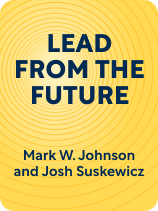

This article is an excerpt from the Shortform book guide to "Lead From the Future" by Mark W. Johnson and Josh Suskewicz. Shortform has the world's best summaries and analyses of books you should be reading.
Like this article? Sign up for a free trial here.
What will your industry look like in 10 years? How will the market change? How might your company need to adjust to meet new demands in a different business landscape?
Drawing on insights from their research and experience working with prominent companies, Mark W. Johnson and Josh Suskewicz provide a practical, three-stage framework that enables you to stay ahead of your competition and unlock new possibilities for your organization. The first stage is creating a vision.
Read on to learn how to create a vision for your business with the three steps provided in Lead From the Future.
Create a Vision for Your Business
The authors break the visionary (“future-back thinking”) process into three stages. They explain (1) how to create a vision for your business, (2) how to convert the vision to strategy, and (3) how to execute the visionary plan. They state that they don’t intend for you to use these stages as a rigid checklist but, instead, as a flexible framework that you can adapt to your company’s unique context and challenges.
The stages of visionary planning work best as a collaborative process that includes regular, structured dialogues between senior leaders informed by the discovery cycle process. These discussions should emphasize exploration over finding consensus and making decisions. The dialogues should include people with diverse perspectives, relevant experience, and knowledge, including those who make resource allocation decisions.
Here, we’ll look in detail at the first stage: creating a vision for your business. This stage involves three steps: anticipating the future market landscape, identifying major implications of this environment for your company, and imagining how your company can fit into that future.
Step 1: Anticipate the Future Landscape
The first task in anticipating what the future landscape will look like is identifying a time horizon—how far into the future to set your vision for the company. The authors recommend you and your team imagine as far into the future as necessary to find the point where you become uncertain of your company’s significance and likely growth. Consider when new paradigms and trends, like technology breakthroughs, may become relevant and mature enough to create market disruptions.
Once you set your target time horizon, discuss what you think the market will look like at this time. Given likely technology and market trends at your target time, what assumptions can you make about market activity? Discuss if there are aspects of your company that would not respond well during these likely disruptions and changes in the future. Additionally, discuss if your customers’ needs will shift and what types of future technology and services you can imagine—or create—to fill those needs.
(Shortform note: In this first step of Stage 1, the authors have advised you to discuss aspects of your company that would not respond well to changes in the future. This discussion, however, is the main theme of the next step of Stage 1. When moving through these steps with your team, it may make more sense to save this discussion for Step 2, as Step 1 aims to create a vision of the future landscape that you can then respond to with changes in your vision and strategy for the company.)
At this point, it’s important to bring together your team’s differing ideas about what the future will look like and create a clear statement about what you think will happen. This statement should be exciting and should summarize a consensus perspective on the future, which will help shape your strategy and get others to support your vision. For instance, you might predict, “By 2050, all personal assistants and routine customer service tasks will be automated by AI.”
| Why Anticipating the Future Is Difficult In Black Swan, Nassim Taleb argues that our ability to anticipate the future—for example, where current trends will lead and what markets will look like years from now—is severely limited. People tend to think they’re good at developing accurate assumptions about the future, but even experts can easily be wrong. Taleb argues that discoveries, like those that produce impactful technological advancements (such as the advent of the internet), are nearly impossible to predict because they are mostly random and the products of chance. Therefore, according to Taleb’s argument, making accurate statements about the future that you can build a visionary plan around would be difficult. Instead of trying to predict the future, Taleb proposes combining a highly conservative approach to risk management with a willingness to take small risks, which can protect against unexpected events while allowing for opportunities for growth and innovation. |
Step 2: Think About How Your Business Will Fare in the Future
In the second step of creating your vision, identify what your company’s future looks like given the assumptions you’ve developed about the future landscape and your current strategies. Discuss with your team whether the company would still have long-term relevance and sustained growth relevance if you continued doing what you’re doing now.
The authors advise that you examine potential threats and opportunities and determine which is likely to play a larger role in your future so that you can develop a strategy to either respond to threats or take advantage of opportunities.
(Shortform note: Many business experts recommend a tool called a SWOT analysis to help you examine potential threats, opportunities, strengths, and weaknesses in your organization and assess how they might affect your visionary strategy. A SWOT analysis identifies internal strengths and weaknesses (factors your company can control or improve upon) and external opportunities and threats (factors that a company must monitor and respond to). By analyzing these factors, companies can gain insights into their competitive position and make informed decisions about future strategies.)
Step 3: Finalize Your Future Vision
Now that you’ve thought about the future landscape at your target time horizon and identified implications for your business, you can construct a future vision. A future vision describes what services or products you’ll offer, how you’ll create value in the market, and how you’ll address necessary factors in future growth—for example, gaps in your company’s current capabilities that need to be modified to support change and growth.
Start with a bird’s eye view of your company’s future by asking yourself: Who will our customers be? What products and services will we offer them? What areas of the world will we serve? What frameworks will we use to organize our company’s activities?
(Shortform note: In Traction, Gino Wickman adds that you should create a marketing strategy as a part of your vision. According to Wickman, a successful marketing plan includes identifying your ideal customers based on factors such as their location, age, and income, creating a list of potential customers that meet that description, and highlighting what sets your business apart from the competition.)
To solidify your vision, the authors recommend you develop a compelling story that describes it. This story should include your company’s larger purpose, a summary of the assumptions you’ve developed about the future, the implications for the business, and how your company will change in response to those implications. A future vision story rooted in your company’s greater purpose will motivate employees and stakeholders and help attract new talent.
An example of a visionary story for a solar panel company could be, “If we don’t take immediate and significant action to address climate change, our future could look very different from our present. Our vision is to create a world where renewable energy is accessible to all. We believe that by developing innovative and sustainable solutions, we can make a significant impact on the planet and improve the lives of people everywhere. Together, we can build a brighter future for generations to come.”
(Shortform note: Wickman provides many ideas for how to share your visionary narrative with your company—for example, you could present your vision at a kickoff meeting or establish priorities for individual departments to support your vision. Wickman says that communicating your vision provides a clear direction to employees to make better vision-informed decisions.)
Exercise: Imagine the Future of Your Organization
The first stage of the visionary planning process is to create your vision, which involves imagining what the future will look like and how your organization will fit into the future. The following exercise walks you through an abbreviated version of creating a vision that you can build a growth strategy around.
- First, think about what the future likely holds for your organization’s sector in five to 10 years. Are there any major shifts or disruptions on the horizon?
- Next, consider your organization’s current state. Are there any key aspects of your organization that will fare well in the future? What are the key challenges to relevancy and growth that your organization will likely face in the future?
- Think about the capabilities and competencies that your organization will need to develop in order to achieve its stay relevant in the future. What steps can you take to build and develop these capabilities over time?
- Finally, think about your role as a leader. How can you model the behaviors and mindsets that will be necessary for your organization to succeed in the future? What steps can you take to enable and empower your team to achieve your shared vision?

———End of Preview———
Like what you just read? Read the rest of the world's best book summary and analysis of Mark W. Johnson and Josh Suskewicz's "Lead From the Future" at Shortform.
Here's what you'll find in our full Lead from the Future summary:
- Why it's important to anticipate future change rather than reacting to it
- A three-stage framework for staying ahead of the competition
- How to understand and adopt the visionary planning process






